Chapter Two
Language + Narrative + Storytelling + Drama
Irene Borger:
You’ve worked with writers before to create libretti – and now you’ve taken that on yourself. What is your experience in working with language, in contrast to sound? (You’ve written that in “Anthracite Fields” you were drawing on many levels of text: oral histories, local rhymes, geological descriptions, a railroad advertisement, a mining accident index, an impassioned speech by John L. Lewis, and a list of everyday activities that make use of coal.)
JW:
It’s interesting that you ask this. My first creative work was with words - writing poetry, plays, prose. When I discovered writing music it was like the floodgates blew open - I could express something I couldn’t express with words. For a long time it was important to me to not use text at all. And then little by little words crept back in. I have worked with some wonderful writers - though even when working with writers I have selected phrases and even single words to set. In these collaborative projects, with writers like Deborah Artman, theater artist Anna Deavere Smith, or comic book artist Ben Katchor, there has always been flexibility in what part of the text to set and how much of the text to set. It felt very natural to return to writing/constructing my own text. I can hear music and sound in the words - which is very exciting. As I am creating text I am often singing it, chanting it, and listening to its rhythm.
IMB:
You said in an interview that you really started out as someone who wrote (playwriting, poetry) “I came through to music from storytelling, writing with words; in a lot of ways it informs my music, this kind of idea that there is, not necessarily a narrative but some kind of a gestalt or image or extra-musical idea in almost every piece of music I’ve written; I’m a storyteller with music.”
Since “story” is generally thought of as using words, what makes a piece of music “a story?”
JW:
There is a story in the energy, depth, density, and dynamics. Music can also be abstract. But for me it is always somehow connected to human energy. Even when it is about the force of nature or intensity of sound for me it relates to human perception of that sound or resonance.
IMB:
In your program notes to “Cruel Sister,” you wrote, “While my piece references no words and quotes no music from the original tune, it does follow the dramatic arc of the ballad — the music reflecting an argument that builds, a body floating on the sea, the mad harp.” Given that, what led you to actually use narrative?
JW:
When the Munich Chamber Orchestra commissioned the piece they asked if I could relate the work to a fairytale or folktale. At first I winced - at the idea of being so literal. But then I remembered a song that I had heard in college. My college roommate played me the ballad “Cruel Sister” that was on an album of the same name by the British folk-rock group Pentangle. I was struck by it’s beauty, purity, and pain - a haunting tale of conflict between two sisters. As a young woman interested in feminism, politics, and psychology the story seemed particularly poignant. It was great to return to it years later, to create this piece.
IMB:
What creates “drama” in your work? And perhaps the shape of drama?
JW:
For example, in “riSE and fLY,” a body concerto, I started very elemental with breath, and sound on the body. There is an evolution in the piece as it becomes more patterned and virtuosic, pushing its way forward until it leaves the body for found objects - tubs and metal grates, etc. This becomes the players drum set. The orchestra is very reactive to the sound and movement of the soloist. The percussionist triggers reactions in the orchestra with a single clap. It seems that his movement drives them.
""When I discovered writing music it was like the floodgates blew open - I could express something I couldn’t express with words.""




